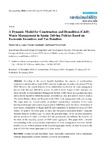A Dynamic Model for Construction and Demolition (C&D) Waste Management in Spain: Driving Policies Based on Economic Incentives and Tax Penalties

View/
Use this link to cite
http://hdl.handle.net/2183/18452Collections
- Investigación (FEE) [923]
Metadata
Show full item recordTitle
A Dynamic Model for Construction and Demolition (C&D) Waste Management in Spain: Driving Policies Based on Economic Incentives and Tax PenaltiesDate
2014Citation
Sustainability 2014, Vol. 6, Pages 416-435
Abstract
According to the recent Spanish legislation, the amount of non-hazardous construction and demolition waste (C&D waste) by weight must be reduced by at least 70% by 2020. However, the current behavior of the stakeholders involved in the waste management process make this goal difficult to achieve. In order to boost changes in their strategies, we firstly describe an Environmental Management System (EMS) based on regulation measures and economic incentives which incorporate universities as a key new actor in order to create a 3Rs model (Reduce, Reuse and Recycle) in the C&D waste management with costs savings. The target areas are focused mainly on producer responsibility, promotion of low-waste building technologies and creation of green jobs to fulfill three main objectives: valorization of inert wastes, elimination of illegal landfills and stimulation of demand for recycled C&D wastes. To achieve this latter goal, we have also designed a simulation model—using the Systems Dynamic methodology—to assess the potential impact of two policies (incentives and tax penalties) in order to evaluate how the government can influence the behavior of the firms in the recycling system of C&D waste aggregates. This paper finds a broader understanding of the socioeconomic implications of waste management over time and the positive effects of these policies in the recycled aggregates market in order to achieve the goal of 30% C&D waste aggregates in 12 years or less.
Keywords
Construction and demolition waste
Sustainable construction
Policy instruments
Strategic management
Systems dynamic
Economic development
Sustainable construction
Policy instruments
Strategic management
Systems dynamic
Economic development
Editor version
Rights
Reconocimiento 3.0
ISSN
2071-1050






